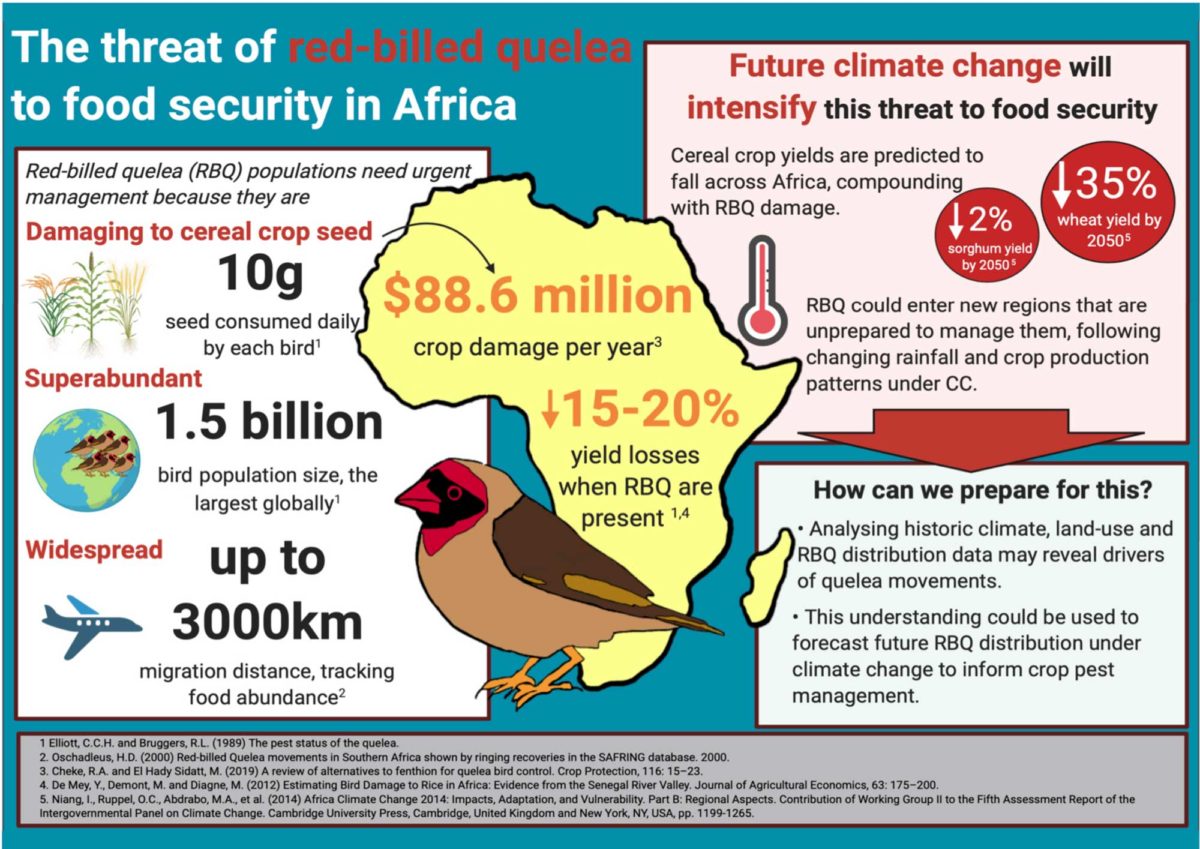Summary
This infographic is a broad introduction to my PhD topic for an audience of undergraduate to PhD-level ecologists that have little knowledge on the red-billed quelea and this species threat to food security. I introduce this crop pest and the basic characteristics that make it a challenging and important species to study, and I briefly describe the methods I am planning to apply in my project.
Transcript
1. Red-billed quelea (RBQ) populations need urgent management because they are:
Damaging to cereal crop seed
Each red-billed quelea consumes 10g of seed every day, including both wild grass and cereal crop seed, including sorghum, rice and wheat. Every year this damage to cereal crops amounts to $88.6 million of losses to farmers in sub-Saharan Africa (in 2018 prices). This is because they reduce yields by 15-20% on agricultural land that they feed on.
Superabundant
With the RBQ being the most abundant bird in the world, this is an enormous challenge to managing their population, and this is a key reason they are such a significant crop pest in Africa. If you consider each bird consumes 10g of seed daily, this is 15 million kg across the continent each day.
Widespread
The RBQ is a highly mobile nomadic migrant, which means they dynamically track food abundance through space and time. This movement can be across large regions of Africa, travelling up to 3000km in a season, and consequently, damage is widespread and impacts a large number of farmers.
2. Future climate change will intensify this threat:
Key cereal crop yields are predicted to fall across Africa under climate change, due to increased intensity of extreme climatic condition such as drought. For example, wheat yields are predicted to fall by 35% by 2050, and Sorghum by 2%. Food security will already be threatened by this phenomenon alone, so additional yield losses from RBQ urgently need to be prevented to reduce the negative socio-economic impacts.
Additionally, changing rainfall and crop production patterns under climate change may result in highly mobile RBQ dispersing into new regions. Affected farms may be unprepared for this crop pest and may suffer even higher losses than are currently observed where management has been implemented.
3. How can we prepare for this?
By analysing how historic climate and land-use patterns are related to past movements of the RBQ, the mechanism that drives RBQ distribution can be understood. With knowledge of future climate and land-use patterns under climate change, we can then forecast where RBQ are likely to be present. This information can then be given to pest control organisations and farms to prepare for RBQ invasion and minimise crop damage.
Rachel Dobson

Rachel is a new PhD student just starting out in the School of Earth and Environment at Leeds this year. Her project will be looking at the red-billed quelea, a hyper abundant, migratory bird that is a damaging cereal crop pest in sub-Saharan Africa. Rachel aim’s to model bird movements, and forecast how climate change will alter crop production and the distribution of this damaging migratory pest to advise essential management and protect future food security in Africa.
Email: eerdo@leeds.ac.uk
Twitter: @RachelDobson98
Organisation: Sustainability Research Institute, University of Leeds

